This is a simple guide for those of you who are interested in growing your own organic flower garden.


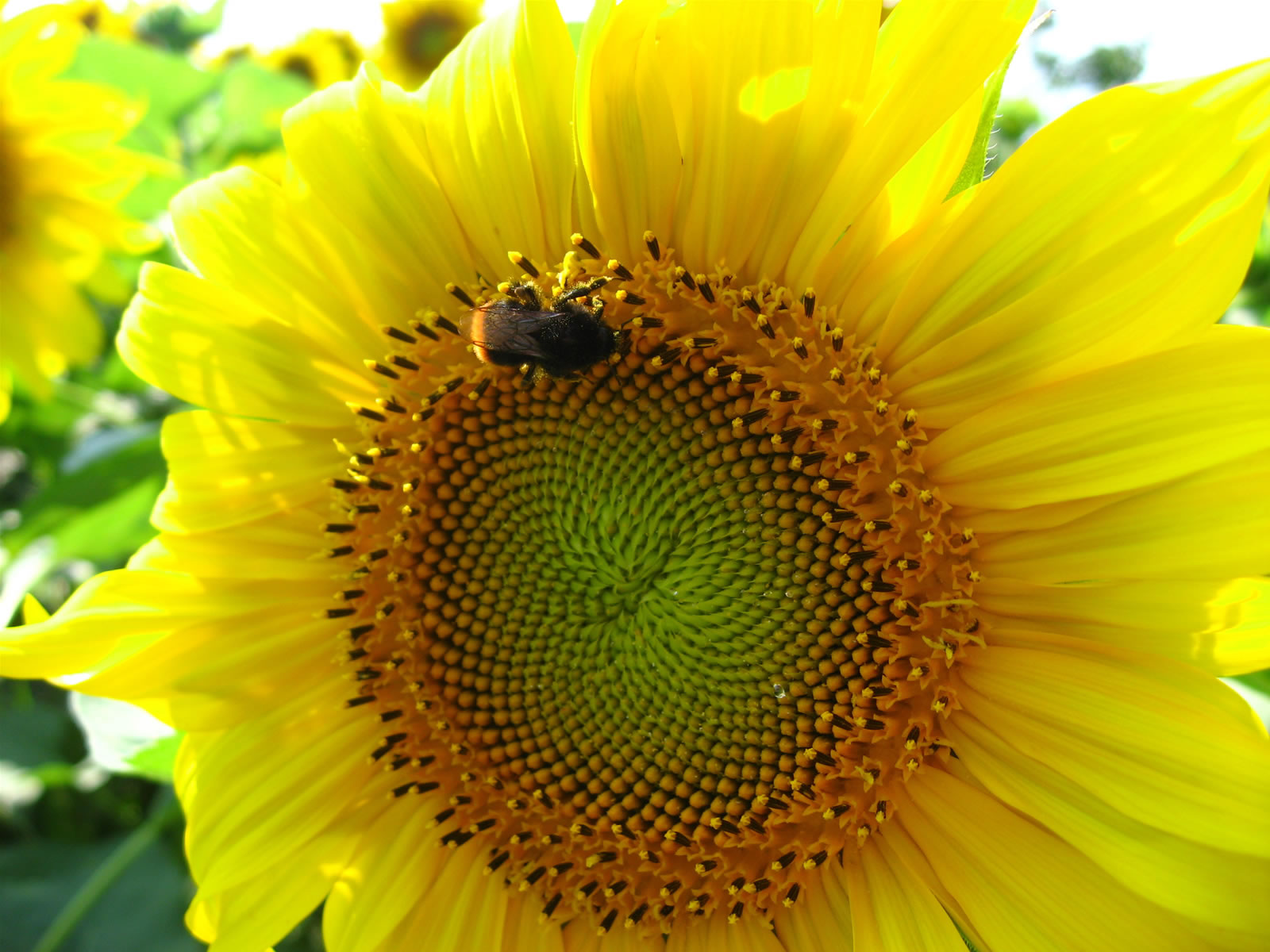

Morphology
A stereotypical flower consists of four kinds of structures attached to the tip of a short stalk. Each of these kinds of parts is arranged in a whorl on the receptacle. The four main whorls (starting from the base of the flower or lowest node and working upwards) are as follows:- Calyx: the outermost whorl consisting of units called sepals; these are typically green and enclose the rest of the flower in the bud stage, however, they can be absent or prominent and petal-like in some species.
- Corolla: the next whorl toward the apex, composed of units called petals, which are typically thin, soft and colored to attract animals that help the process of pollination.
- Androecium (from Greek andros oikia: man's house): the next whorl (sometimes multiplied into several whorls), consisting of units called stamens. Stamens consist of two parts: a stalk called a filament, topped by an anther where pollen is produced by meiosis and eventually dispersed.
- Gynoecium (from Greek gynaikos oikia: woman's house): the innermost whorl of a flower, consisting of one or more units called carpels. The carpel or multiple fused carpels form a hollow structure called an ovary, which produces ovules internally. Ovules are megasporangia and they in turn produce megaspores by meiosis which develop into female gametophytes. These give rise to egg cells. The gynoecium of a flower is also described using an alternative terminology wherein the structure one sees in the innermost whorl (consisting of an ovary, style and stigma) is called a pistil. A pistil may consist of a single carpel or a number of carpels fused together. The sticky tip of the pistil, the stigma, is the receptor of pollen. The supportive stalk, the style, becomes the pathway for pollen tubes to grow from pollen grains adhering to the stigma.
The four main parts of a flower are generally defined by their positions on the receptacle and not by their function. Many flowers lack some parts or parts may be modified into other functions and/or look like what is typically another part. In some families, like Ranunculaceae, the petals are greatly reduced and in many species the sepals are colorful and petal-like. Other flowers have modified stamens that are petal-like, the double flowers of Peonies and Roses are mostly petaloid stamens.[1] Flowers show great variation and plant scientists describe this variation in a systematic way to identify and distinguish species.
Specific terminology is used to describe flowers and their parts. Many flower parts are fused together; fused parts originating from the same whorl are connate, while fused parts originating from different whorls are adnate, parts that are not fused are free. When petals are fused into a tube or ring that falls away as a single unit, they are sympetalous (also called gamopetalous.) Connate petals may have distinctive regions: the cylindrical base is the tube, the expanding region is the throat and the flaring outer region is the limb. A sympetalous flower, with bilateral symmetry with an upper and lower lip, is bilabiate. Flowers with connate petals or sepals may have various shaped corolla or calyx including: campanulate, funnelform, tubular, urceolate, salverform or rotate.
Many flowers have a symmetry. When the perianth is bisected through the central axis from any point, symmetrical halves are produced, forming a radial symmetry. These flowers are also known to be actinomorphic or regular, e.g. rose or trillium. When flowers are bisected and produce only one line that produces symmetrical halves the flower is said to be irregular or zygomorphic, e.g. snapdragon or most orchids.
Flowers may be directly attached to the plant at their base (sessile—the supporting stalk or stem is highly reduced or absent). The stem or stalk subtending a flower is called a peduncle. If a peduncle supports more than one flower, the stems connecting each flower to the main axis are called pedicels. The apex of a flowering stem forms a terminal swelling which is called the torus or receptacle.
Floral formula
- Ca = calyx (sepal whorl; e. g. Ca5 = 5 sepals)
- Co = corolla (petal whorl; e. g., Co3(x) = petals some multiple of three )
- Z = add if zygomorphic (e. g., CoZ6 = zygomorphic with 6 petals)
- A = androecium (whorl of stamens; e. g., A∞ = many stamens)
- G = gynoecium (carpel or carpels; e. g., G1 = monocarpous)
∞: to represent "many"
A floral formula would appear something like this:
- Ca5Co5A10 - ∞G1
Inflorescence
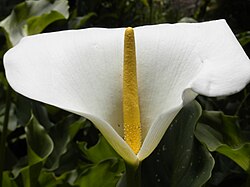
The familiar calla lily is not a single flower. It is actually an inflorescence of tiny flowers pressed together on a central stalk that is surrounded by a large petal-like bract.
TOPICS
Home & garden gardening
The third edition of Flower Show, being organised by Tamil Nadu Agricultural University (TNAU), would be held here from January nine.
The “Covai Flower Show,’ organised as part of the Centenary celebrations of TNAU in 2005, had to be discontinued after the second edition in 2006, due to various reasons, despite overwhelming response from the public and is being revived now, TNAU Vice-Chancellor Dr Murugesh Bhoopathi told reporters here today.
The main objective of the two-day show, jointly organised by Rotary Coimbatore Uptown, was to educate the children and public through entertainment to love nature and to conserve environment, he said.
The show would ultimately bring together flower and garden industry professionals, buyers, wholesalers, importers and growers from all over the country, he said.
About 200 to 250 varieties of flowers would be on display including those imported from Holland, Malaysia, Thailand as ’Dutch Decoration Gallery,’ Indian cut and loose flowers and bonsai, Bhoopathi said.
landscaping
hobby gardening
lifestyle and leisure tourism
The third edition of Flower Show, being organised by Tamil Nadu Agricultural University (TNAU), would be held here from January nine.
The “Covai Flower Show,’ organised as part of the Centenary celebrations of TNAU in 2005, had to be discontinued after the second edition in 2006, due to various reasons, despite overwhelming response from the public and is being revived now, TNAU Vice-Chancellor Dr Murugesh Bhoopathi told reporters here today.
The main objective of the two-day show, jointly organised by Rotary Coimbatore Uptown, was to educate the children and public through entertainment to love nature and to conserve environment, he said.
The show would ultimately bring together flower and garden industry professionals, buyers, wholesalers, importers and growers from all over the country, he said.
About 200 to 250 varieties of flowers would be on display including those imported from Holland, Malaysia, Thailand as ’Dutch Decoration Gallery,’ Indian cut and loose flowers and bonsai, Bhoopathi said.
Main article: InflorescenceAn inflorescence may include specialized stems and modified leaves known as bracts.
Development
A flower is a modified stem tip with compressed internodes, bearing structures that are highly modified leaves.[2] In essence, a flower develops on a modified shoot or axis from a determinate apical meristem (determinate meaning the axis grows to a set size).Flowering transition
The transition to flowering is one of the major phase changes that a plant makes during its life cycle. The transition must take place at a time that is favorable for fertilization and the formation of seeds, hence ensuring maximal reproductive success. To meet these needs a plant is able to interpret important endogenous and environmental cues such as changes in levels of plant hormones and seasonable temperature and photoperiod changes.[3] Many perennial and most biennial plants require vernalization to flower. The molecular interpretation of these signals is through the transmission of a complex signal known as florigen, which involves a variety of genes, including CONSTANS, FLOWERING LOCUS C and FLOWERING LOCUS T. Florigen is produced in the leaves in reproductively favorable conditions and acts in buds and growing tips to induce a number of different physiological and morphological changes.[4] The first step is the transformation of the vegetative stem primordia into floral primordia. This occurs as biochemical changes take place to change cellular differentiation of leaf, bud and stem tissues into tissue that will grow into the reproductive organs. Growth of the central part of the stem tip stops or flattens out and the sides develop protuberances in a whorled or spiral fashion around the outside of the stem end. These protuberances develop into the sepals, petals, stamens, and carpels. Once this process begins, in most plants, it cannot be reversed and the stems develop flowers, even if the initial start of the flower formation event was dependent of some environmental cue.[5] Once the process begins, even if that cue is removed the stem will continue to develop a flower.Organ development
The molecular control of floral organ identity determination is fairly well understood. In a simple model, three gene activities interact in a combinatorial manner to determine the developmental identities of the organ primordia within the floral meristem. These gene functions are called A, B and C-gene functions. In the first floral whorl only A-genes are expressed, leading to the formation of sepals. In the second whorl both A- and B-genes are expressed, leading to the formation of petals. In the third whorl, B and C genes interact to form stamens and in the center of the flower C-genes alone give rise to carpels. The model is based upon studies of homeotic mutants in Arabidopsis thaliana and snapdragon, Antirrhinum majus. For example, when there is a loss of B-gene function, mutant flowers are produced with sepals in the first whorl as usual, but also in the second whorl instead of the normal petal formation. In the third whorl the lack of B function but presence of C-function mimics the fourth whorl, leading to the formation of carpels also in the third whorl. See also The ABC Model of Flower Development.Most genes central in this model belong to the MADS-box genes and are transcription factors that regulate the expression of the genes specific for each floral organ.
Floral function
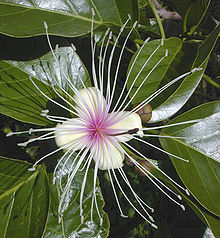
An example of a "perfect flower", this Crateva religiosa flower has both stamens (outer ring) and a pistil (center).
In the majority of species, individual flowers have both functional carpels and stamens. These flowers are described by botanists as being perfect or bisexual. Some flowers lack one or the other reproductive organ and called imperfect or unisexual If unisex flowers are found on the same individual plant but in different locations, the species is said to be monoecious. If each type of unisex flower is found only on separate individuals, the plant is dioecious.
Flower specialization and pollination
Further information: Pollination syndrome
Flowering plants usually face selective pressure to optimize the transfer of their pollen, and this is typically reflected in the morphology of the flowers and the behaviour of the plants. Pollen may be transferred between plants via a number of 'vectors'. Some plants make use of abiotic vectors — namely wind (anemophily) or, much less commonly, water (hydrophily). Others use biotic vectors including insects (entomophily), birds (ornithophily), bats (chiropterophily) or other animals. Some plants make use of multiple vectors, but many are highly specialised.Cleistogamous flowers are self-pollinated, after which they may or may not open. Many Viola and some Salvia species are known to have these types of flowers.
The flowers of plants that make use of biotic pollen vectors commonly have glands called nectaries that act as an incentive for animals to visit the flower. Some flowers have patterns, called nectar guides, that show pollinators where to look for nectar. Flowers also attract pollinators by scent and color. Still other flowers use mimicry to attract pollinators. Some species of orchids, for example, produce flowers resembling female bees in color, shape, and scent. Flowers are also specialized in shape and have an arrangement of the stamens that ensures that pollen grains are transferred to the bodies of the pollinator when it lands in search of its attractant (such as nectar, pollen, or a mate). In pursuing this attractant from many flowers of the same species, the pollinator transfers pollen to the stigmas—arranged with equally pointed precision—of all of the flowers it visits.
Anemophilous flowers use the wind to move pollen from one flower to the next. Examples include grasses, birch trees, ragweed and maples. They have no need to attract pollinators and therefore tend not to be "showy" flowers. Male and female reproductive organs are generally found in separate flowers, the male flowers having a number of long filaments terminating in exposed stamens, and the female flowers having long, feather-like stigmas. Whereas the pollen of animal-pollinated flowers tends to be large-grained, sticky, and rich in protein (another "reward" for pollinators), anemophilous flower pollen is usually small-grained, very light, and of little nutritional value to animals.
Pollination
Main article: Pollination
The primary purpose of a flower is reproduction. Since the flowers are the reproductive organs of plant, they mediate the joining of the sperm, contained within pollen, to the ovules — contained in the ovary. Pollination is the movement of pollen from the anthers to the stigma. The joining of the sperm to the ovules is called fertilization. Normally pollen is moved from one plant to another, but many plants are able to self pollinate. The fertilized ovules produce seeds that are the next generation. Sexual reproduction produces genetically unique offspring, allowing for adaptation. Flowers have specific designs which encourages the transfer of pollen from one plant to another of the same species. Many plants are dependent upon external factors for pollination, including: wind and animals, and especially insects. Even large animals such as birds, bats, and pygmy possums can be employed. The period of time during which this process can take place (the flower is fully expanded and functional) is called anthesis.Attraction methods
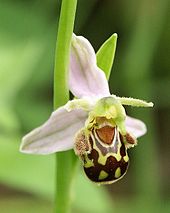
A Bee orchid has evolved over many generations to better mimic a female bee to attract male bees as pollinators.
Still other flowers use mimicry to attract pollinators. Some species of orchids, for example, produce flowers resembling female bees in color, shape, and scent. Male bees move from one such flower to another in search of a mate.
Pollination mechanism
The pollination mechanism employed by a plant depends on what method of pollination is utilized.Most flowers can be divided between two broad groups of pollination methods:
Entomophilous: flowers attract and use insects, bats, birds or other animals to transfer pollen from one flower to the next. Often they are specialized in shape and have an arrangement of the stamens that ensures that pollen grains are transferred to the bodies of the pollinator when it lands in search of its attractant (such as nectar, pollen, or a mate). In pursuing this attractant from many flowers of the same species, the pollinator transfers pollen to the stigmas—arranged with equally pointed precision—of all of the flowers it visits. Many flowers rely on simple proximity between flower parts to ensure pollination. Others, such as the Sarracenia or lady-slipper orchids, have elaborate designs to ensure pollination while preventing self-pollination.
Some flowers are self-pollinated and use flowers that never open or are self-pollinated before the flowers open, these flowers are called cleistogamous. Many Viola species and some Salvia have these types of flowers.
Flower-pollinator relationships
Many flowers have close relationships with one or a few specific pollinating organisms. Many flowers, for example, attract only one specific species of insect, and therefore rely on that insect for successful reproduction. This close relationship is often given as an example of coevolution, as the flower and pollinator are thought to have developed together over a long period of time to match each other's needs.This close relationship compounds the negative effects of extinction. The extinction of either member in such a relationship would mean almost certain extinction of the other member as well. Some endangered plant species are so because of shrinking pollinator populations.
Fertilization and dispersal
Main article: biological dispersal
Some flowers with both stamens and a pistil are capable of self-fertilization, which does increase the chance of producing seeds but limits genetic variation. The extreme case of self-fertilization occurs in flowers that always self-fertilize, such as many dandelions. Conversely, many species of plants have ways of preventing self-fertilization. Unisexual male and female flowers on the same plant may not appear or mature at the same time, or pollen from the same plant may be incapable of fertilizing its ovules. The latter flower types, which have chemical barriers to their own pollen, are referred to as self-sterile or self-incompatible (see also: Plant sexuality).Evolution
Further information: Evolution of flowers
 |  |  |
| Half kg Cake + 24 red roses Basket Rs 1499 $ 30.00Net Banking/Debit/Cash Card /Credit CardsBUY | 100 Roses in a BasketPrice: Rs 2200 US $ 50.00Net Banking/Debit/Cash Cards BUY Credit Card | 36 Red Roses Heart Shaped ArrangementPrice: Rs 1100 US $ 22.00Net Banking/Debit/Cash Cards BUY Credit Card |
 |  |  |
| No: exotic-flowers-4 Pink Carnations and Yellow Gladioli in a Basket Price: Rs 750 US $ 15.00Net Banking/Debit/Cash Cards SEND Credit Card | No: exotic-flowers-3 Red Carnation and Yellow Liliums Price: Rs 1200 US $ 25.00Net Banking/Debit/Cash Cards SEND Credit Card | No: exotic-flowers-8 Large Arrangement-3 to 4 feet- of Mix flowers Price: Rs 2450 US $ 51.00Net Banking/Debit/Cash Cards SEND Credit Car |

50 Red Roses+24 Ferrero Rocher Chocolates+1/2 Kg Cake
Price: Rs.3500 US$79.00 Net Banking/Debit/Cash Cards BUY Credit Card |  24 red roses basket+4 temptation chocolates+1 kg Cake+card 24 red roses basket+4 temptation chocolates+1 kg Cake+card |
Recent DNA analysis (molecular systematics)[7][8] shows that Amborella trichopoda, found on the Pacific island of New Caledonia, is the sister group to the rest of the flowering plants, and morphological studies[9] suggest that it has features which may have been characteristic of the earliest flowering plants.
The general assumption is that the function of flowers, from the start, was to involve animals in the reproduction process. Pollen can be scattered without bright colors and obvious shapes, which would therefore be a liability, using the plant's resources, unless they provide some other benefit. One proposed reason for the sudden, fully developed appearance of flowers is that they evolved in an isolated setting like an island, or chain of islands, where the plants bearing them were able to develop a highly specialized relationship with some specific animal (a wasp, for example), the way many island species develop today. This symbiotic relationship, with a hypothetical wasp bearing pollen from one plant to another much the way fig wasps do today, could have eventually resulted in both the plant(s) and their partners developing a high degree of specialization. Island genetics is believed to be a common source of speciation, especially when it comes to radical adaptations which seem to have required inferior transitional forms. Note that the wasp example is not incidental; bees, apparently evolved specifically for symbiotic plant relationships, are descended from wasps.
Likewise, most fruit used in plant reproduction comes from the enlargement of parts of the flower. This fruit is frequently a tool which depends upon animals wishing to eat it, and thus scattering the seeds it contains.
While many such symbiotic relationships remain too fragile to survive competition with mainland organisms, flowers proved to be an unusually effective means of production, spreading (whatever their actual origin) to become the dominant form of land plant life.
While there is only hard proof of such flowers existing about 130 million years ago, there is some circumstantial evidence that they did exist up to 250 million years ago. A chemical used by plants to defend their flowers, oleanane, has been detected in fossil plants that old, including gigantopterids,[10] which evolved at that time and bear many of the traits of modern, flowering plants, though they are not known to be flowering plants themselves, because only their stems and prickles have been found preserved in detail; one of the earliest examples of petrification.
The similarity in leaf and stem structure can be very important, because flowers are genetically just an adaptation of normal leaf and stem components on plants, a combination of genes normally responsible for forming new shoots.[11] The most primitive flowers are thought to have had a variable number of flower parts, often separate from (but in contact with) each other. The flowers would have tended to grow in a spiral pattern, to be bisexual (in plants, this means both male and female parts on the same flower), and to be dominated by the ovary (female part). As flowers grew more advanced, some variations developed parts fused together, with a much more specific number and design, and with either specific sexes per flower or plant, or at least "ovary inferior".
Flower evolution continues to the present day; modern flowers have been so profoundly influenced by humans that many of them cannot be pollinated in nature. Many modern, domesticated flowers used to be simple weeds, which only sprouted when the ground was disturbed. Some of them tended to grow with human crops, and the prettiest did not get plucked because of their beauty, developing a dependence upon and special adaptation to human affection.[12]
Symbolism
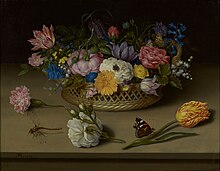
Flowers are common subjects of still life paintings, such as this one by Ambrosius Bosschaert the Elder
Main article: Language of flowers
Many flowers have important symbolic meanings in Western culture. The practice of assigning meanings to flowers is known as floriography. Some of the more common examples include:- Red roses are given as a symbol of love, beauty, and passion.
- Poppies are a symbol of consolation in time of death. In the United Kingdom, New Zealand, Australia and Canada, red poppies are worn to commemorate soldiers who have died in times of war.
- Irises/Lily are used in burials as a symbol referring to "resurrection/life". It is also associated with stars (sun) and its petals blooming/shining.
- Daisies are a symbol of innocence.
The great variety of delicate and beautiful flowers has inspired the works of numerous poets, especially from the 18th-19th century Romantic era. Famous examples include William Wordsworth's I Wandered Lonely as a Cloud and William Blake's Ah! Sun-Flower.
Because of their varied and colorful appearance, flowers have long been a favorite subject of visual artists as well. Some of the most celebrated paintings from well-known painters are of flowers, such as Van Gogh's sunflowers series or Monet's water lilies. Flowers are also dried, freeze dried and pressed in order to create permanent, three-dimensional pieces of flower art.
The Roman goddess of flowers, gardens, and the season of Spring is Flora. The Greek goddess of spring, flowers and nature is Chloris.
In Hindu mythology, flowers have a significant status. Vishnu, one of the three major gods in the Hindu system, is often depicted standing straight on a lotus flower.[13] Apart from the association with Vishnu, the Hindu tradition also considers the lotus to have spiritual significance.[14] For example, it figures in the Hindu stories of creation. (EHow) The lovely aroma of flo
 wering plants can awaken the senses, giving a person a true appreciation for nature. Growing your own organic flower garden can bring the beauty of nature to your own back yard, without harmful pesticides. This can be a real treat both for you and the flowers. Pesticides can take a toll on your health and even reduce the life span of your flowers. Toxic chemicals such as mancozeb and chlorothalonil have been labeled as carcinogens. A carcinogen is a substance that is known to cause cancer. Pesticides and herbicides are toxic substances that kill living organisms. The Organic Trade Association has stated that side effects from pesticide exposure range from nausea, asthma, headaches and fatigue, to more serious side effects such as cancer and neurological disorders.
wering plants can awaken the senses, giving a person a true appreciation for nature. Growing your own organic flower garden can bring the beauty of nature to your own back yard, without harmful pesticides. This can be a real treat both for you and the flowers. Pesticides can take a toll on your health and even reduce the life span of your flowers. Toxic chemicals such as mancozeb and chlorothalonil have been labeled as carcinogens. A carcinogen is a substance that is known to cause cancer. Pesticides and herbicides are toxic substances that kill living organisms. The Organic Trade Association has stated that side effects from pesticide exposure range from nausea, asthma, headaches and fatigue, to more serious side effects such as cancer and neurological disorders. You will need:Step 1: Select a spot in your yard where the flowers are likely to get plenty of sun shine.
Organic seed compost
Flower seeds
Natural predators
Organic sulfur spray
Pruning sheers
Garden tiller
Step 2: Prepare the soil. Loosen the dirt with a garden tiller. Sprinkle organic seed compost on the dirt.
Step 3: Choose the type of flowers you would like to plant. Buy organic flower seeds at your local nursery or online (see Resources).
Step 4: Soak your seeds. Prior to planting your organic flower seeds, pre-soak the seeds. Soak the seeds in purified water, preferably distilled. Soak the seeds for 15 to 24 hours before planting. This will help the seeds soak up additional moisture.
Step 5: Dig several small holes in the dirt where your seeds will be planted. Plant and cover your seeds in the dirt. Lightly water the seeds.
Step 6: Wait for your flowers to grow. Water your flowers early in the morning on a daily basis.
Step 7: Keep up with pruning. Mildew and black spots can show up on flowers without warning. If the problem is not taken care of right away the disease will spread to other flowers. Prune any diseased flowers and spray all the flowers with organic sulfur spray (see Resources). Spray the flower itself, and the leaves.
Step 8: Allow natural predators in your garden. For an organic garden to flourish, the garden must have beneficial insects, such as lady bugs, praying mantis, ambush bugs, spiders and lacewings. Include plenty of these friendly little critters. Lady bugs can be purchased at many garden centers or online (see Resources).
|
The third edition of Flower Show, being organised by Tamil Nadu Agricultural University (TNAU), would be held here from January nine.
The “Covai Flower Show,’ organised as part of the Centenary celebrations of TNAU in 2005, had to be discontinued after the second edition in 2006, due to various reasons, despite overwhelming response from the public and is being revived now, TNAU Vice-Chancellor Dr Murugesh Bhoopathi told reporters here today.
The main objective of the two-day show, jointly organised by Rotary Coimbatore Uptown, was to educate the children and public through entertainment to love nature and to conserve environment, he said.
The show would ultimately bring together flower and garden industry professionals, buyers, wholesalers, importers and growers from all over the country, he said.
About 200 to 250 varieties of flowers would be on display including those imported from Holland, Malaysia, Thailand as ’Dutch Decoration Gallery,’ Indian cut and loose flowers and bonsai, Bhoopathi said.
  |       | 
The Gold of Kinabalu: orchid treasure on the edge of extinction
The beauties only surface in the shadiest of nurseries and high prices for their lives are agreed under the counter by hungry-eyed collectors. This is not the plot from a harrowing tale of people smuggling but the fate of rare and highly prized orchids. The plants have inspired frenzied collection since the 18th century with their lustrous blooms and incredible variety. Now, scientists say the illegal collection of orchids is pushing species to the edge of extinction, with dire consequences for biodiversity. With some vulnerable species available on the black market before they can even be formally named, biologists and customs officers alike are battling to preserve the captivating plants. Sex appeal Admired for their beauty, orchids make up the largest family of flowering plants (Orchidaceae) with over 26,000 species.  The plants vary enormously from tiny 3-4mm Bulbophyllum minutissimum to 20m long vanillas: lianas that grow high up in rainforest. The plants vary enormously from tiny 3-4mm Bulbophyllum minutissimum to 20m long vanillas: lianas that grow high up in rainforest.What unites them is the unique way they germinate from seeds, developing a tuberous mass of cells to form a seedling plant. For orchid admirers however it is the sensual differences between the plants that inspire such admiration and many are driven wild by the unique shape, scent and sight of new species. Victorian Britons referred to the condition as “orchidelerium”, an insatiable lust for collecting the plants. From delicate ghost orchids to the beautifully coloured petals of Cattleya, the aesthetic appeal of orchids is obvious. Throughout history the plants have been considered “overtly sexual” with voluptuous blooms sporting enlarged lips (labellum): pouting platforms to entice insect pollinators. But the individuality and appeal of orchids also makes them vulnerable. “Orchids are naturally rare with many species only being known from a handful of populations,” says orchid expert Dr David Roberts from the Durrell Institute of Conservation and Ecology at the University of Kent, UK. “Smuggling only affects the groups that are specifically in demand which isn’t all orchids. However for the groups that are sought after, such as slipper orchids, it is a big problem.” High price Rare species can fetch a pretty penny; a single stem of the Rotchschild’s Orchid (Paphiopedilum rothschildianum), known as the Gold of Kinabalu, is reported to command prices of around $5000. After its discovery in 1987 this slipper orchid, remarkable for its imposing horizontal petals, was stripped from the wild by orchid smugglers bringing it close to extinction. Despite reintroduction of the plant from cultivated seedlings, it is still described as endangered and its few known wild locations in Kinabalu National Park in Sabah, Malaysia are kept a closely guarded secret. However, not all species are afforded the same protection. Last year, Asian orchid expert Dr Jaap J Vermeulen studied an orchid collected by conservationists in a national park in Sarawak, Malaysia. But before he could describe the new species to science, it had been introduced to the black market. “Bulbophyllum kubahense is a particularly beautiful species with a dense [cluster] of fairly large, white, heavily purple spotted flowers. That makes it desirable to orchid growers,” Dr Vermeulen explains. “Traders found the species in a conservation area, and first thought that is was a particularly luxuriant form of another, similar looking species… Plants appeared in nurseries in Sarawak, Singapore and Thailand.” Through his analysis, published in the journal Plant Systematics and Evolution, Dr Vermeulen confirmed that the plant was a “true novelty”. “It is beautiful, and it is rare: only known from a single locality near Kuching, Sarawak. That will put the price up, and with it the collecting pressure on the natural population,” he warns. Populations stripped This is not the first time an orchid has been endangered before it has even been formally described. Such is the demand from collectors, smugglers scour the globe for new species of orchid, sometimes removing whole populations of plants before anyone else knows of their existence. Dr Vermeulen cites examples from peninsular Malaysia and Vietnam but the most famous example comes from Peru. Phragmipedium kovachii was first found in 2001 and is referred to as one of the most important natural history discoveries of the last decade. A foot tall with striking purple blooms, it is a distinctive member of the lady’s slipper family, named for their slipper-shaped petal pouches. Orchid dealer James Kovach bought the orchid from a roadside vendor in Peru and travelled back to his native US with it. Within days, the Peruvian authorities asked the US Fish and Wildlife Service to investigate the plant, as all Phragmipedium are banned from export under the Convention on International Trade in Endangered Species (CITES). After its initial description, illegally plucked specimens of P. kovachii were reportedly changing hands amongst frenzied growers for as much as $10,000. Kovach received two years probation and was made to pay a fine of $1000 for violating the endangered species act. 
Experts and customs officers join forces to protect vulnerable
Although conservationists acknowledge the prosecution, they say the fines are not high enough to deter smugglers from their billion dollar enterprise. “To a dedicated collector of wild-sourced orchids, price has no bearing,” says Dr Richard Thomas, from the wildlife trade monitoring network Traffic International. Dr Thomas says it is “notoriously difficult” to estimate the value of illicit trade. Ruthless collection According to Traffic’s figures, the legal trade in live orchids in Europe alone involves more than 370 million plants. These orchids adhere to the CITES regulations: they come from licensed nurseries that hold the appropriate permits for international trade. In these nurseries, single specimens are duplicated through micropropagation: creating thousands of cloned plants for the consumer market. Despite advances, this process is costly and time-consuming. The cloned plants are also considered inferior by collectors that value the variety in wild orchids’ blooms. “There are a small number of hard core ‘collectors’ for whom only a wild-sourced orchid will do, and they can be ruthless in their pursuit of this goal,” says Dr Thomas. “This can have a devastating impact on newly discovered species, where there is likely to be a demand created for the plant almost overnight.” Protecting the future The UK’s rarest orchid, Cypripedium calceolus, receives round-the-clock police surveillance where it grows on a Lancashire golf course. But this level of protection is not globally consistent. In the rainforests of South America and Asia, protecting individual species is an epic task. Beyond the practical difficulties of surveying entire rainforests with limited resources, conservationists also have to contend with the pressures of developing nations. According to the International Union for Conservation of Nature’s orchid specialist group, tropical orchid habitat is vanishing as timber is removed, minerals mined and land cleared for roads and housing. Some collectors insist that, by removing orchids from areas under threat from human development, they are protecting the future of species. For some orchids, their only hope lies in ex-situ conservation: cultivation in nurseries is the only thing keeping species like Paphiopedilum vietnamenese from extinction. In the interests of biodiversity however, conservationists maintain that orchids must be protected in their natural environment. “For species with highly restricted ranges and severely threatened habitat, any removal of wild specimens poses a significant threat,” says Dr Thomas. “The loss of any one species is a tragedy – the world needs rich biological diversity to survive. Species have taken millennia to evolve, but can be lost in days.” 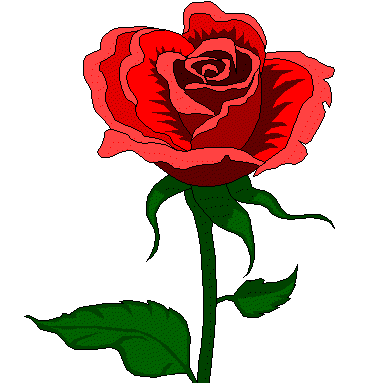 In modern times, people have sought ways to cultivate, buy, wear, or otherwise be around flowers and blooming plants, partly because of their agreeable appearance and smell. Around the world, people use flowers for a wide range of events and functions that, cumulatively, encompass one's lifetime:
Flowers provide less food than other major plants parts (seeds, fruits, roots, stems and leaves) but they provide several important foods and spices. Flower vegetables include broccoli, cauliflower and artichoke. The most expensive spice, saffron, consists of dried stigmas of a crocus. Other flower spices are cloves and capers. Hops flowers are used to flavor beer. Marigold flowers are fed to chickens to give their egg yolks a golden yellow color, which consumers find more desirable. Dandelion flowers are often made into wine. Bee Pollen, pollen collected from bees, is considered a health food by some people. Honey consists of bee-processed flower nectar and is often named for the type of flower, e.g. orange blossom honey, clover honey and tupelo honey. Hundreds of fresh flowers are edible but few are widely marketed as food. They are often used to add color and flavor to salads. Squash flowers are dipped in breadcrumbs and fried. Edible flowers include nasturtium, chrysanthemum, carnation, cattail, honeysuckle, chicory, cornflower, Canna, and sunflower. Some edible flowers are sometimes candied such as daisy and rose (you may also come across a candied pansy). Flowers can also be made into tisanes or "herbal teas". Dried flowers such as chrysanthemum, rose, jasmine, camomile are infused into tea both for their fragrance and medical properties. Sometimes, they are also mixed with tea leaves for the added fragrance. Flowers have been used since as far back as 50,000 years in funeral rituals. Many cultures do draw a connection between flowers and life and death, and because of their seasonal return flowers also suggest rebirth, which is the why many people place flowers upon graves. In ancient times the Greeks would place a crown of flowers on the head of the deceased as well as cover the tomb with wreaths and flower petals, rich and powerful women in ancient Egypt would wear floral headdresses and necklaces upon their death as representations of renewal and a joyful afterlife, and the Mexicans to this day use flowers prominently in their Day of the Dead celebrations in the same way that their Aztec ancestors did. |








































































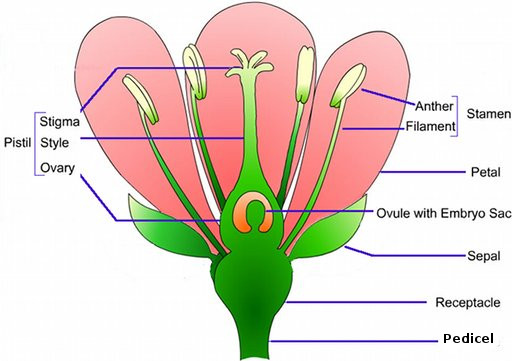
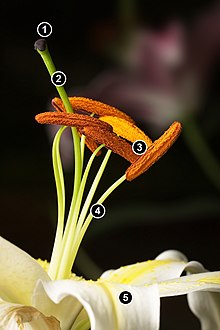


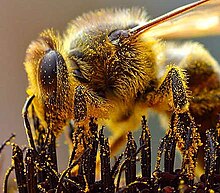
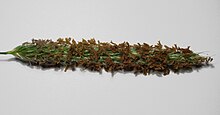


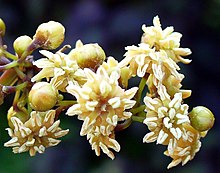


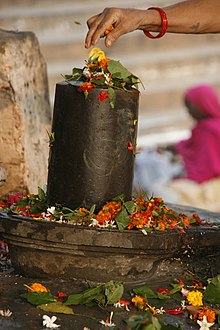

Time for masti & lots of fun too....
ReplyDeleteTime for us to look forward
to some HOLI DHAMAKA with you!
COME $ MAKE OUR BASH a REAL SPLASH !
HAPPY HOLI to you the best color of my life!
ReplyDelete